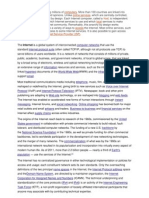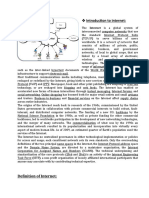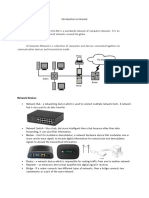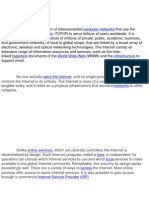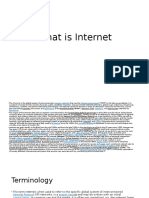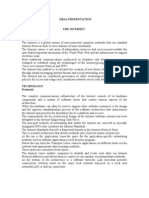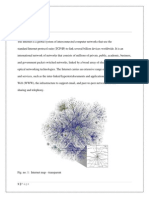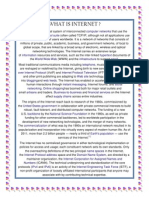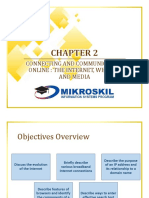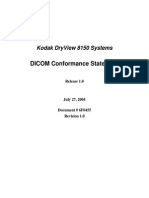INTRODUCTION OF INTERNET
The Internet is a global system of interconnected computer networks that use the standard Internet Protocol Suite (TCP/IP) to serve billions of users worldwide. It is a network of networks that consists of millions of private, public, academic, business, and government networks, of local to global scope, that are linked by a broad array of electronic, wireless and optical networking technologies. The Internet carries a vast range of information resources and services, such as the inter-linked hypertext documents of the World Wide Web (WWW) and the infrastructure to support electronic mail. Most traditional communications media including telephone, music, film, and television are reshaped or redefined by the Internet, giving birth to new services such as Voice over Internet Protocol (VoIP) and IPTV. Newspaper, book and other print publishing are adapting to Web site technology, or are reshaped into blogging and web feeds. The Internet has enabled or accelerated new forms of human interactions through instant messaging, Internet forums, and social networking. Online shopping has boomed both for major retail outlets and small artisans and traders. Business-to-business and financial services on the Internet affect supply chains across entire industries. The origins of the Internet reach back to research of the 1960s, commissioned by the United States government in collaboration with private commercial interests to build robust, faulttolerant, and distributed computer networks. The funding of a new U.S. backbone by the National Science Foundation in the 1980s, as well as private funding for other commercial backbones, led to worldwide participation in the development of new networking technologies, and the merger of many networks. The commercialization of what was by the 1990s an international network resulted in its popularization and incorporation into virtually every aspect of modern human life. As of 2009, an estimated quarter of Earth's population used the services of the Internet. The Internet has no centralized governance in either technological implementation or policies for access and usage; each constituent network sets its own standards. Only the overreaching definitions of the two principal name spaces in the Internet, the Internet Protocol address space and the Domain Name System, are directed by a maintainer organization, the Internet Corporation for Assigned Names and Numbers (ICANN). The technical underpinning and standardization of the core protocols (IPv4 and IPv6) is an activity of the Internet Engineering Task Force (IETF), a non-profit organization of loosely affiliated international participants that anyone may associate with by contributing technical expertise. Internet is a short form of the technical term internetwork,[1] the result of interconnecting computer networks with special gateways or routers. The Internet is also often referred to as the Net. The term the Internet, when referring to the entire global system of IP networks, has been treated as a proper noun and written with an initial capital letter. In the media and popular culture a trend has also developed to regard it as a generic term or common noun and thus write it as "the
�internet", without capitalization. Some guides specify that the word should be capitalized as a noun but not capitalized as an adjective.
The terms Internet and World Wide Web are often used in everyday speech without much distinction. However, the Internet and the World Wide Web are not one and the same. The Internet is a global data communications system. It is a hardware and software infrastructure that provides connectivity between computers. In contrast, the Web is one of the services communicated via the Internet. It is a collection of interconnected documents and other resources, linked by hyperlinks and URLs.[2] In many technical illustrations when the precise location or interrelation of Internet resources is not important, extended networks such as the Internet are often depicted as a cloud.[3] The verbal image has been formalized in the newer concept of cloud computing.
INTRODUCTION OF MULTIMEDIA
Multimedia is media and content that uses a combination of different content forms. The term can be used as a noun (a medium with multiple content forms) or as an adjective describing a medium as having multiple content forms. The term is used in contrast to media which only use traditional forms of printed or hand-produced material. Multimedia includes a combination of text, audio, still images, animation, video, and interactivity content forms. Multimedia is usually recorded and played, displayed or accessed by information content processing devices, such as computerized and electronic devices, but can also be part of a live performance. Multimedia (as an adjective) also describes electronic media devices used to store and experience multimedia content. Multimedia is distinguished from mixed media in fine art; by including audio, for example, it has a broader scope. The term "rich media" is synonymous for interactive multimedia. Hypermedia can be considered one particular multimedia application Examples of individual content forms combined in multimedia:
Text
Audio
Still Images
Animation
Video
Interactivity
�Footage
Multimedia may be broadly divided into linear and non-linear categories. Linear active content progresses without any navigational control for the viewer such as a cinema presentation. Nonlinear content offers user interactivity to control progress as used with a computer game or used in self-paced computer based training. Hypermedia is an example of non-linear content. Multimedia presentations can be live or recorded. A recorded presentation may allow interactivity via a navigation system. A live multimedia presentation may allow interactivity via an interaction with the presenter or performer.
Use of multimedia
Creative industries
Creative industries use multimedia for a variety of purposes ranging from fine arts, to entertainment, to commercial art, to journalism, to media and software services provided for any of the industries listed below. An individual multimedia designer may cover the spectrum throughout their career. Request for their skills range from technical, to analytical, to creative.
Commercial
�Much of the electronic old and new media used by commercial artists is multimedia. Exciting presentations are used to grab and keep attention in advertising. Business to business, and interoffice communications are often developed by creative services firms for advanced multimedia presentations beyond simple slide shows to sell ideas or liven-up training. Commercial multimedia developers may be hired to design for governmental services and nonprofit services applications as well.
Entertainment and fine arts
In addition, multimedia is heavily used in the entertainment industry, especially to develop special effects in movies and animations. Multimedia games are a popular pastime and are software programs available either as CD-ROMs or online. Some video games also use multimedia features. Multimedia applications that allow users to actively participate instead of just sitting by as passive recipients of information are called Interactive Multimedia. In the Arts there are multimedia artists, whose minds are able to blend techniques using different media that in some way incorporates interaction with the viewer..
Education
In Education, multimedia is used to produce computerbased training courses (popularly called CBTs) and
�reference books like encyclopedia and almanacs. A CBT lets the user go through a series of presentations, text about a particular topic, and associated illustrations in various information formats. Edutainment is an informal term used to describe combining education with entertainment, especially multimedia entertainment.
Journalism
Newspaper companies all over are also trying to embrace the new phenomenon by implementing its practices in their work. While some have been slow to come around, other major newspapers like The New York Times, USA Today and The Washington Post are setting the precedent for the positioning of the newspaper industry in a globalized world.
Engineering
Software engineers may use multimedia in Computer Simulations for anything from entertainment to training such as military or industrial training. Multimedia for software interfaces are often done as a collaboration between creative professionals and software engineers.
Industry
In the Industrial sector, multimedia is used as a way to help present information to shareholders, superiors and
�coworkers. Multimedia is also helpful for providing employee training, advertising and selling products all over the world via virtually unlimited web-based technology
Mathematical and scientific research
In mathematical and scientific research, multimedia is mainly used for modeling and simulation. For example, a scientist can look at a molecular model of a particular substance and manipulate it to arrive at a new substance. Representative research can be found in journals such as the Journal of Multimedia.
Medicine
In Medicine, doctors can get trained by looking at a virtual surgery or they can simulate how the human body is affected by diseases spread by viruses and bacteria and then develop techniques to prevent it.
Document imaging
Document imaging is a technique that takes hard copy of an image/document and converts it into a digital format (for example, scanners).
Disabilities
�Ability Media allows those with disabilities to gain qualifications in the multimedia field so they can pursue careers that give them access to a wide array of powerful communication forms.


